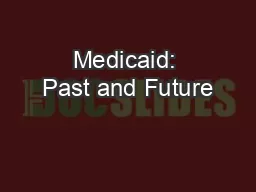

Presentation to the Center for Children and Families Georgetown University July 22 2015 Growth in Medicaid Role and Market Influence Now single largest source of health insurance in the nation ID: 427437
Download Presentation The PPT/PDF document "Medicaid: Past and Future" is the property of its rightful owner. Permission is granted to download and print the materials on this web site for personal, non-commercial use only, and to display it on your personal computer provided you do not modify the materials and that you retain all copyright notices contained in the materials. By downloading content from our website, you accept the terms of this agreement.
Slide1
Medicaid: Past and Future
Presentation to the Center for Children and Families
Georgetown University
July 22, 2015Slide2
Growth in Medicaid Role and Market Influence
Now single largest source of health insurance in the
nation
Pre-ACA in 2013
Projected in 2015
ESI
47%
Medicaid 16%
Medicare
15%
Uninsured14%
Other Private 6%
ESI
47%
Medicaid
22%
Medicare
15%
Uninsured 7%
Other Private 3%
Exchanges 4%
U.S. Health Insurance Enrollment by Source
Source: National
Health Expenditure Projections 2011-2021
http://www.cms.gov/Research-Statistics-Data-and-Systems/Statistics-Trends-and-Reports/NationalHealthExpendData/Downloads/Proj2011PDF.pdf
CHIP
1%
CHIP
2%Slide3
“
Categorical” Eligibility: Not Enough to be
Poor
Eligibility for Medicaid Linked
to
Eligibility for WelfareMedicaid Started as An Adjunct to Welfare Programs
Application
for Welfare was the Application for Medicaid
Long applications
In-person interviews at
welfare
office
Applicants required to prove
eligibility with paper-based
documentation
Other requirements often imposed
Enrollment not encouragedSlide4
Medicaid has
also played a historic role of meeting
care needs of
special populations
Key Turning Points for Eligibility and Enrollment
Welfare Reform: Eligibility For Parents De-Linked from Welfare
1996
Expansions for Children/De-Linked from Welfare
1988–1990
CHIP
Created/
Medicaid Application Process Simplified for Children
1997+
With ACA, Medicaid shifts
to broad-based
coverageSlide5
The New Coverage ParadigmSlide6
New Coverage Paradigm
Sources:
http
://
www.ncsl.org/portals/1/documents/health/TFCMannLS12.pdf
; http://kff.org/medicaid/fact-sheet/medicaid-eligibility-for-adults-as-of-january-1-2014/
Medicaid is one of three Insurance Affordability Programs providing a continuum of subsidized insurance for those without affordable ESICoverage gap in median non-expansion statesOther Adults
Jobless Parents
Pregnant Women
Working Parents
Children
Varies by State
Medicaid/CHIP Children
133% FPL
48% FPL
33% FPL
100% FPL
4
00% FPL
241% FPL
Exchange Subsidies
AdultsSlide7
Making the Coverage Continuum Work
Simplified Eligibility Rules - Aligned With Marketplace
One Application for the 3 Insurance Affordability Programs
No In-Person interviews: Online Application (or In-Person, Mail, Phone)
Data-driven Verifications and Renewals
One IT System or Shared Service Across Programs
Applicant enrolled in whichever program is appropriateSlide8
Medicaid as Health Insurance:
Real Time Eligibility
Improved online application processes allow states to verify application information against electronic sources, all during one application sitting.
Rhode Island
estimates it can process up to two thirds of its Medicaid applications for enrollees subject
to new ACA rules
without manual intervention or additional information being required from the applicant
Continuity of coverage at renewal is also improving as states implement data-driven verification processes and reduce paperwork requirements.
Washington
estimates it can renew coverage for up to two thirds of enrollees subject to new ACA rules without requiring additional action or information from enrolleesSlide9
What’s Next?Slide10
Ensuring Coverage
Completing the Transition
Ending the Coverage Gap
Seamless
Enrollment
Data-Driven Verification
“Real time” Eligibility Determinations“Non-Magi” Simplifications Multi-Benefit Applications Continuous Coverage
Eligible for Medicaid
…But Not Enrolled
Medicaid ExpansionSlide11
30 States Have Expanded Medicaid
California
Nevada
Arizona
Utah
Idaho
Montana
Wyoming
Maine
Vermont
New York
North Carolina
South Carolina
Alabama
Nebraska
Georgia
Mississippi
Louisiana
Texas
Oklahoma
Pennsylvania
Wisconsin
Minnesota
North Dakota
Ohio
South Dakota
Kansas
Iowa
Illinois
Tennessee
Missouri
Delaware
New Jersey
Connecticut
Massachusetts
Virginia
Maryland
Rhode Island
Hawaii
New Hampshire
Not Expanded Medicaid (21)
Alaska
Expanded Medicaid (
29
+ DC)
West
Virginia
Colorado
New Mexico
Oregon
Washington
Michigan
Arkansas
Kentucky
Washington, DC
Medicaid expansion decisions
a
s of June 2015
.
Montana
has passed legislation to implement an
waiver-based expansion and the waiver review process is pending
Iowa
Waiver-Based Medicaid Expansions (5)
Indiana
5 States
Expanding through Section 1115 WaiversSlide12
Features of Alternative Medicaid Expansions
Premiums
Premium Assistance – Marketplace and ESI
Cost Sharing
Health Savings-Like Accounts
Healthy
Behavior IncentivesConnecting to Work, but no work requirementsSlide13
Returning to Welfare Paradigm?
Work requirements
Time limits
Policies inconsistent
with Medicaid’s
role
as an insurer
:Slide14
Delivery System and Payment Reform:
What’s a Child Advocate to Do?
Accountable Care Organizations
Attribution
Up and Down Side Risk
Risk Corridors
Integrated Care Networks
Shared Savings
Core Measures
Community Care Organizations
DSHP
Bundled Payments
DSRIPSlide15
New Managed Care Proposed Regulations
Principle of Alignment
Encouraging Value Based Purchasing
Opportunities for State Direction/Incentives
Beneficiary Protections
Choosing a Plan
Appropriate Use of Service Authorizations
Accountability
State
Oversight and Data
Requirements
MLR
Examples
Comments Due July 27, 2015Slide16
Block Grants
Per Capita Caps
Medicaid “Reform”: Follow the Money
?Slide17
Medicaid Spending Growth in Context
Source:
http
://
blogs.wsj.com/washwire/2015/04/16/public-vs-private-health-insurance-on-controlling-spending
/
Medicaid spending growth has been driven largely by enrollment. Per capita growth slower than private insurance and Medicare.Slide18
Celebrate the Gains!Slide19
Historic Gains in Childrens’ Coverage
Source:
http://www.childstats.gov/americaschildren/tables/hc1.asp/
The uninsurance rate for children has been cut in half since 1997
Uninsured Rates Among U. S. Children (0-17)
1997
2013
uninsured
insuredSlide20
ACA Resulted in Dramatic Drop in Uninsurance
Gallup found sharp declines in the number of U.S. adults indicating
a lack of health insurance coverage between 2014 and 2015
http://www.gallup.com/poll/182348/uninsured-rate-dips-first-quarter.aspxSlide21
Decline of 33%
Decline of 49%
Source: Urban Institute Health Reform Monitoring Survey:
http
://hrms.urban.org/quicktakes/Trends-in-Uninsurance-and-State-Marketplace-and-Medicaid-Expansion-Decisions.html
ACA Resulted in Dramatic Drop in Uninsurance, Cont.Slide22
Happy 10
th
Anniversary to CCF and Its Partners!!